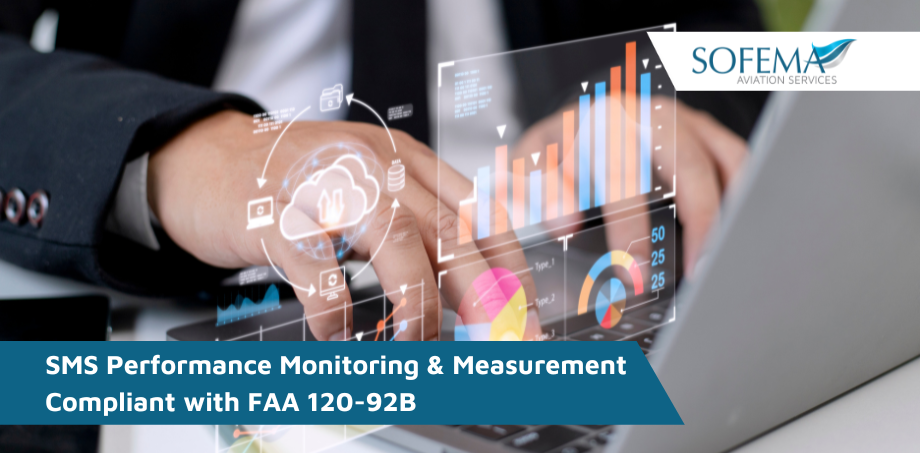SMS for Aviation Service Providers process review by Sofema Aviation Services (SAS)
Introduction – Safety Performance Monitoring and Measurement:
The certificate holder must develop and maintain processes and systems to acquire data with respect to its operations, products, and services to monitor the safety performance of the organization.
- These processes and systems must include at a minimum monitoring of operational processes.
o Example – day-to-day basis (e.g., direct supervision of employee activities, monitoring of pilot currency, and monitoring Minimum Equipment List (MEL) status).
o Reviewing data that is collected for operational purposes to look for anything of safety significance.
o Monitoring products and services from outside sources that are used in the certificate holder’s operations.
Safety Performance Monitoring and Measurement Scalability
- Small Organisations: data/information-gathering typically from normal business processes. For example, regularly reviewing (e.g., weekly, monthly, or quarterly) the flight dispatch logs and crewmember duty records.
- Medium Organisations: Line managers and departmental or key management personnel may observe and review day-to-day activity, noting work task inconsistencies and potential safety issues. Flight operations quality assurance (FOQA) and Line Operations Safety Audit (LOSA) programs may also be sources of information to monitor operations.
- Large Organisations: may involve multiple levels of management, safety professionals, functional area managers, trained auditors/analysts, and teams/groups of line managers. FOQA and LOSA programs may be employed.
o Operational processes may need to be coordinated across adjacent work function boundaries, so effective monitoring may also need to be coordinated.
Monitoring of the Operational Environment
- Monitoring the operational environment of a system is developed from the system analysis that is conducted under Safety Review Management (SRM).
- The operational environment must be monitored to assess impacts on aviation safety.
SMS Auditing
- Should typically involve the operational management responsible for the system(s) being audited.
- Procedures for auditing should describe your audit process, criteria, scope, frequency, method for selecting auditors, and methods of documentation and recordkeeping.
- Audit planning should take into account the safety criticality of the processes to be audited and the results of previous audits.
Note: Auditors should not audit their own work, but may audit the work of others around them in the same department.
- Audit procedures should include the responsibilities and expectations for planning, conducting, reporting results of audits, maintaining records of audit results, and processes for auditing contractors and vendors, as necessary.
SMS Auditing Scalability
- Small: The auditing process could be carried out periodically by AM or Key management person.
o Audits may be carried out as a sub-function of normal business processes.
- Medium: accomplished by operational departmental personnel, on a periodic basis, as determined by the needs of operational decision makers.
- Large: The auditing processes are typically fulfilled by divisional auditors on a consistent basis.
o May already have safety and safety/quality auditors who perform this function or, in smaller divisions, they may be performed by personnel from inside the divisions.
Evaluation of SMS and Operational Processes and Systems
An evaluation is an internal oversight tool that provides the accountable executive with a snapshot of the safety performance of the carrier’s operational processes and systems, as well as SMS processes.
The evaluation should include all available data about the organization, including information from the audits conducted by the operational management.
- Conducting evaluations at planned intervals will help the carrier’s management to determine if its safety management methods and practices are meeting safety objectives and expectations set out in the safety policy.
- Evaluation planning should take into account the safety criticality of the processes that are being evaluated and the results from previous evaluations.
- The scope, content, and frequency of evaluations should be based on the decision maker’s need for information to assess the health of operational processes and the SMS.
Evaluation of SMS and Operational Processes and Systems – Scalability
- Small: Evaluation periodically by the AM or key management person, as a collateral duty under the direction of the accountable executive.
- Medium: Director of Safety (DOS) or Safety Department on a monthly, quarterly, or other periodic basis.
o Personnel resources to perform the observations and data collection for evaluations could be from a small, dedicated department or selected line personnel as a collateral duty.
- Large: Evaluations could be accomplished by a Safety Department or an Internal Evaluation Program (IEP) office on a quarterly, annual, or other periodic basis.
Next Steps
Follow this link to our Library to find & Download related support documents.
Sofema Aviation Services www.sassofia.com & Sofema Online www.sofemaonline.com offer Safety Management System Training as Classroom, Webinar or Online. Please see the websites or email team@sassofia.com
Tags:
aviation, Safety Management System SMS, Sofema Aviation Services, Audit, SMS, FOQA, Aviation SMS, SAS blogs, Safety Performance Monitoring, Safety performance monitoring and measurement, Aviation Service Providers, FAA 120-92B, SMS Auditing, Line Operations Safety Audit (LOSA)




